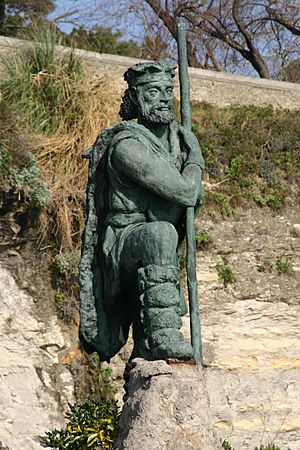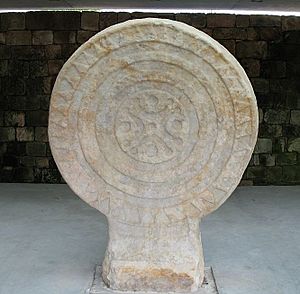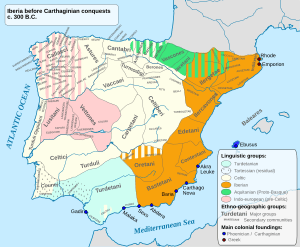Cantabri facts for kids
The Cantabri were an ancient group of people who lived in the northern coastal part of what is now Spain. They were a strong group of tribes before the Romans arrived. Their land became part of the Roman province of Hispania Tarraconensis in 19 BC, after a series of big wars called the Cantabrian Wars.
Contents
What's in a Name?
The name Cantabri comes from Latin. It likely means "Highlanders" or "mountain people." This name probably came from an old word, *cant-, which meant "mountain." Later, in the Middle Ages and modern times, the name often referred to the Basques.
Where Did They Live?

The land of the Cantabri, called Cantabria, covered a large area in the mountains along the northern Spanish coast. This included all of modern Cantabria province, eastern Asturias, and parts of Castile and León. After the Romans took over, this area became smaller, mostly just Cantabria and eastern Asturias.
History of the Cantabri
Where They Came From
The Romans believed the ancestors of the Cantabri moved to the Iberian Peninsula around 400 BC. They thought these people were a mix of different groups, more so than other Celtic peoples in the area.
By the 1st century BC, the Cantabri were made up of about eleven tribes. These tribes included the Avarigines, Blendii, Camarici, Concani, Coniaci, Morecani, Noegi, Orgenomesci, Plentuisii, Salaeni, Vadinienses, and Vellici. They formed a group of tribes with their main town, Aracillum, located in the important Besaya river valley. Other important Cantabrian hillforts were Villeca, Bergida, and Amaya.
Experts have studied the old place-names in Cantabria. They found many Celtic words, which suggests that Celtic people lived there. This supports the idea that Celtic people settled in the Iberian Peninsula by traveling along the Atlantic Ocean coast.
Early Days and Roman Fights

The Cantabri were known as tough and independent mountain people. They were famous for their fighting spirit and love of freedom. Roman writers described them as fierce warriors. They were often hired as mercenaries (soldiers who fight for money).
The first mentions of the Cantabri are from ancient historians like Livy. They wrote about Cantabrian mercenaries fighting for Carthage in the late 3rd century BC. During the 2nd Punic War, some Cantabri fought in Hannibal's army. Others fought against the Romans in the Celtiberian Wars in the 2nd century BC.
One story tells how a Roman army was fighting near Numantia in 137 BC. A rumor spread that a large group of Cantabri and Vaccaei fighters were coming. This caused 20,000 Roman soldiers to panic and run away, forcing their general to surrender. This shows how feared the Cantabri were!
The Cantabrian Wars
In the early 1st century BC, the Cantabri sometimes helped Roman generals. But they also supported rebellions against Rome and raided Roman areas. This made them a problem for the Romans. They sided with Pompey during the Sertorian Wars (82–72 BC). They even sent an army to help tribes in Gaul against Julius Caesar's forces in 56 BC, but they lost badly.
The Cantabri also raided their neighbors, the Vaccaei, Turmodigi, and Autrigones, because they wanted their rich lands. This, along with their support for a Vaccaei revolt in 29 BC, led to the First Cantabrian Wars. The Roman Emperor Augustus himself led the Roman army to conquer them. The Romans won, and the remaining Cantabri people and their lands became part of the new Roman province.
However, the Romans' harsh rules caused more problems. There were many uprisings, including a big slave revolt in 20 BC. Fighting continued until the early 1st century AD. Finally, the region was given some local self-rule when it became part of the new Hispania Tarraconensis province.
Becoming More Roman
Even though the Romans built towns and military camps in Cantabria, the Cantabri never fully became Roman. They kept many parts of their Celtic language, religion, and culture for a long time. They also kept their fighting skills. Cantabrian soldiers joined the Roman Imperial army as auxiliary troops (helpers). These troops fought in places like Britain in AD 43–60.
Later Years
The Cantabri reappeared in history during the chaotic Migration Period in the late 4th century. They began to become Christian. In the 6th century, they were strongly defeated by the Visigoths. However, Cantabria and its people are mentioned again later, during the Visigoth wars against the Vascones in the late 7th century. They only fully adopted the Latin language and culture after the Muslim Conquest of Iberia in the 8th century.
Cantabrian Culture
According to ancient writers, Cantabria had mines for gold, silver, tin, lead, iron, and amber. But not much is known about them. One writer, Strabo, also mentioned salt mines. He described a special custom where, after a child was born, the mother would get up, and the father would go to bed to be cared for by the mother. This was a unique tradition!
Cantabrian Religion

Like their neighbors, the Cantabri believed in many gods and goddesses. They worshipped them in sacred oak or pine forests, on mountains, near rivers, and in small countryside shrines.
It seems the Cantabri did not practice Druidism. However, they did have priests who performed special ceremonies. These included ritual steam baths, festive dances, oracles (ways to get advice from gods), divination (predicting the future), and sacrifices of humans and animals. Strabo wrote that the people of the northwest sacrificed horses to a God of War. Other writers added that the Concani tribe drank the horse's blood during these ceremonies.
See also
 In Spanish: Cántabros para niños
In Spanish: Cántabros para niños
- Astures
- Cantabria
- Cantabrian Wars
- Corocotta
- Sertorian Wars
- Duchy of Cantabria


